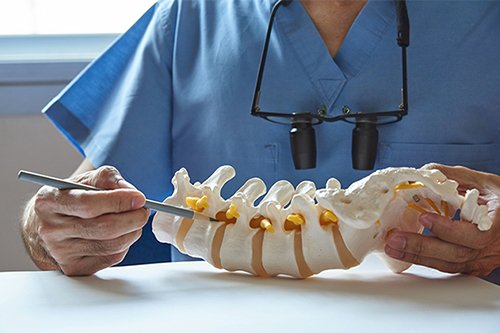Spine Surgery
Spine surgery is a medical procedure performed to address various conditions affecting the spine, which is the backbone of the human body. Spine surgery aims to alleviate pain, improve function, and stabilize the spine in cases where non-surgical treatments have not provided sufficient relief. There are different types of spine surgeries, each tailored to address specific spinal conditions.
Types of Spine Surgery: Some common types of spine surgery include:
- Discectomy: Removal of part or all of a herniated or damaged disc that is compressing a nerve.

- Spinal Fusion: Joining two or more vertebrae together to stabilize the spine and reduce pain.
- Laminectomy: Removal of part of the vertebral bone (lamina) to relieve pressure on the spinal cord and nerves.
- Vertebroplasty and Kyphoplasty: Procedures to treat spinal compression fractures by injecting bone cement into the fractured vertebrae.
- Spinal Decompression: Relieving pressure on nerves or the spinal cord through various techniques.
Symptoms
- Pain: It is normal to experience pain at the surgical site and surrounding areas after spine surgery. The intensity of pain can vary, and it is typically managed with pain medications prescribed by the surgeon.
- Swelling and Bruising: Swelling and bruising around the incision site are common after surgery. It is a natural part of the healing process and should gradually improve over time.
- Limited Mobility: Initially, patients may experience limited mobility and stiffness in the back or neck. This is expected after spine surgery and should improve with time and proper rehabilitation.
- Numbness or Tingling: Some patients may experience temporary numbness or tingling in the extremities, particularly if the surgery involved relieving pressure on nerves that were compressed before the procedure.
- Weakness: Weakness in the muscles surrounding the surgical area may be experienced, especially immediately after surgery. Physical therapy is crucial for regaining strength.
- Incision Site Discomfort: Discomfort or sensitivity around the surgical incision site is normal. Keeping the incision clean and following post-operative care instructions can help minimize any complications.
- Fatigue: It is common to feel fatigued or tired after spine surgery, as the body is healing and recovering from the stress of the procedure.
Treatment
Discectomy: A discectomy is a surgical procedure to remove a part or the entire damaged intervertebral disc that is causing pressure on the spinal nerves. It is often performed to relieve symptoms caused by herniated discs, which can lead to sciatica and nerve compression.
Spinal Fusion: Spinal fusion involves fusing two or more vertebrae together using bone grafts or implants. This procedure is typically performed to stabilize the spine, reduce pain, and correct spinal deformities caused by conditions like degenerative disc disease, spondylolisthesis, or spinal fractures.
Laminectomy: A laminectomy, also known as decompression surgery, involves removing part of the lamina (a bony plate on the back of each vertebra) to create more space for the spinal nerves. This surgery is performed to treat spinal stenosis, a condition where the spinal canal narrows and puts pressure on the spinal cord or nerves.
Spinal Disc Replacement: In some cases, rather than a fusion, a damaged disc can be replaced with an artificial disc to maintain spinal motion and alleviate pain. This procedure is called spinal disc replacement or disc arthroplasty.
Benefits
- Pain Relief: One of the primary reasons for undergoing spine surgery is to alleviate chronic and debilitating back or neck pain caused by various spinal conditions, such as herniated discs, spinal stenosis, degenerative disc disease, or spinal fractures.
- Improved Function and Mobility: Spine surgery aims to correct structural abnormalities or stabilize the spine, which can result in improved function and mobility. Patients often experience an increase in their ability to perform daily activities and regain lost functionality.
- Nerve Compression Relief: Conditions like herniated discs or spinal stenosis can compress nerves in the spinal column, leading to pain, numbness, and weakness in the arms or legs. Spine surgery can relieve this compression, reducing nerve-related symptoms.
- Stabilization of the Spine: Spinal fusion surgery, in particular, can stabilize the spine by fusing two or more vertebrae together, promoting better alignment and preventing abnormal movements that cause pain.
- Correcting Spinal Deformities: Some spine surgeries are performed to correct spinal deformities, such as scoliosis or kyphosis, which can improve posture and overall alignment.
